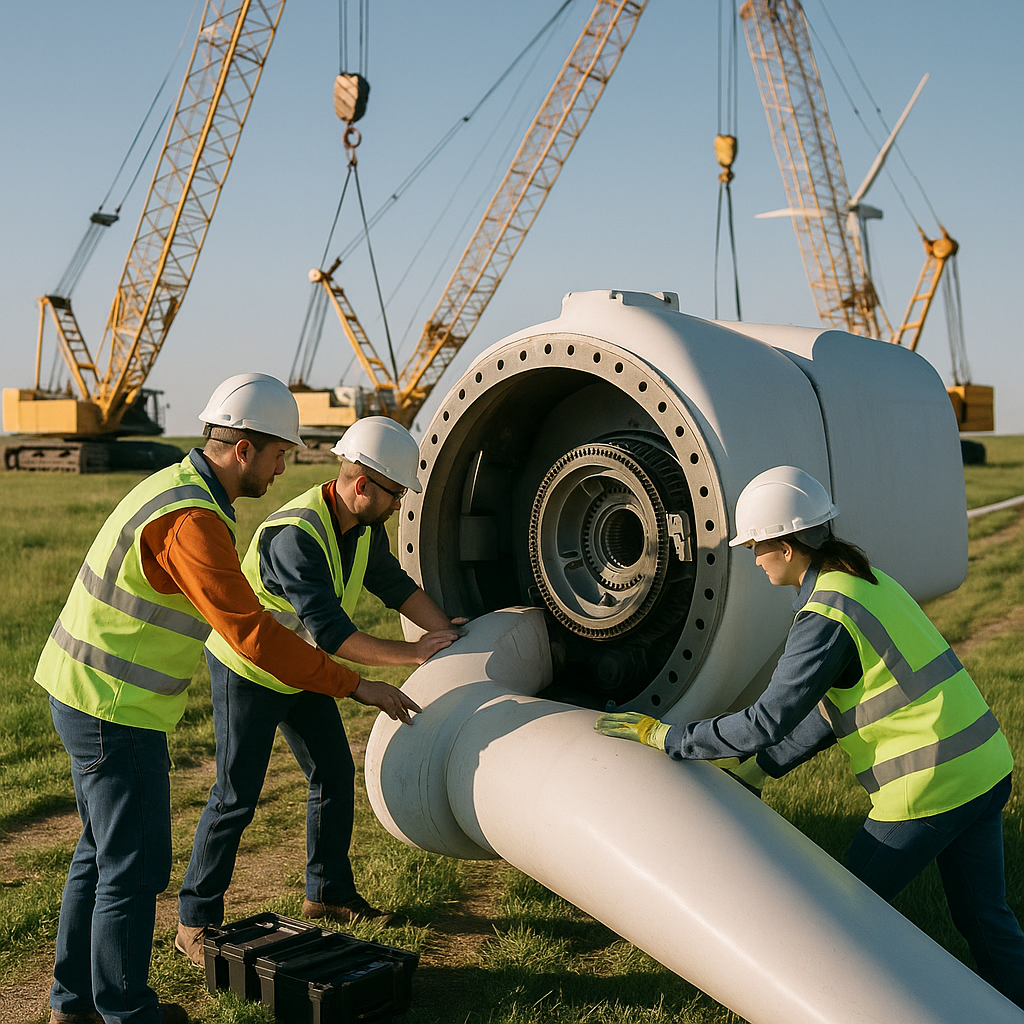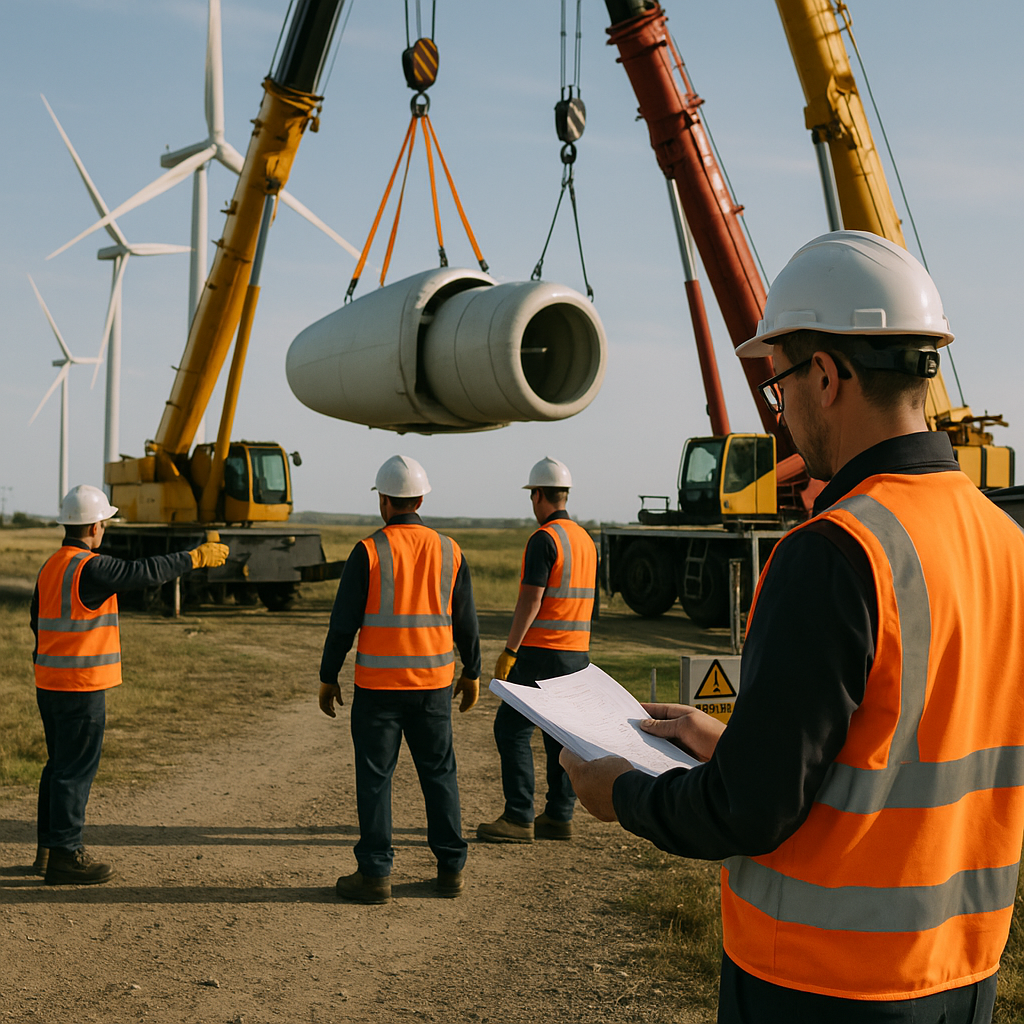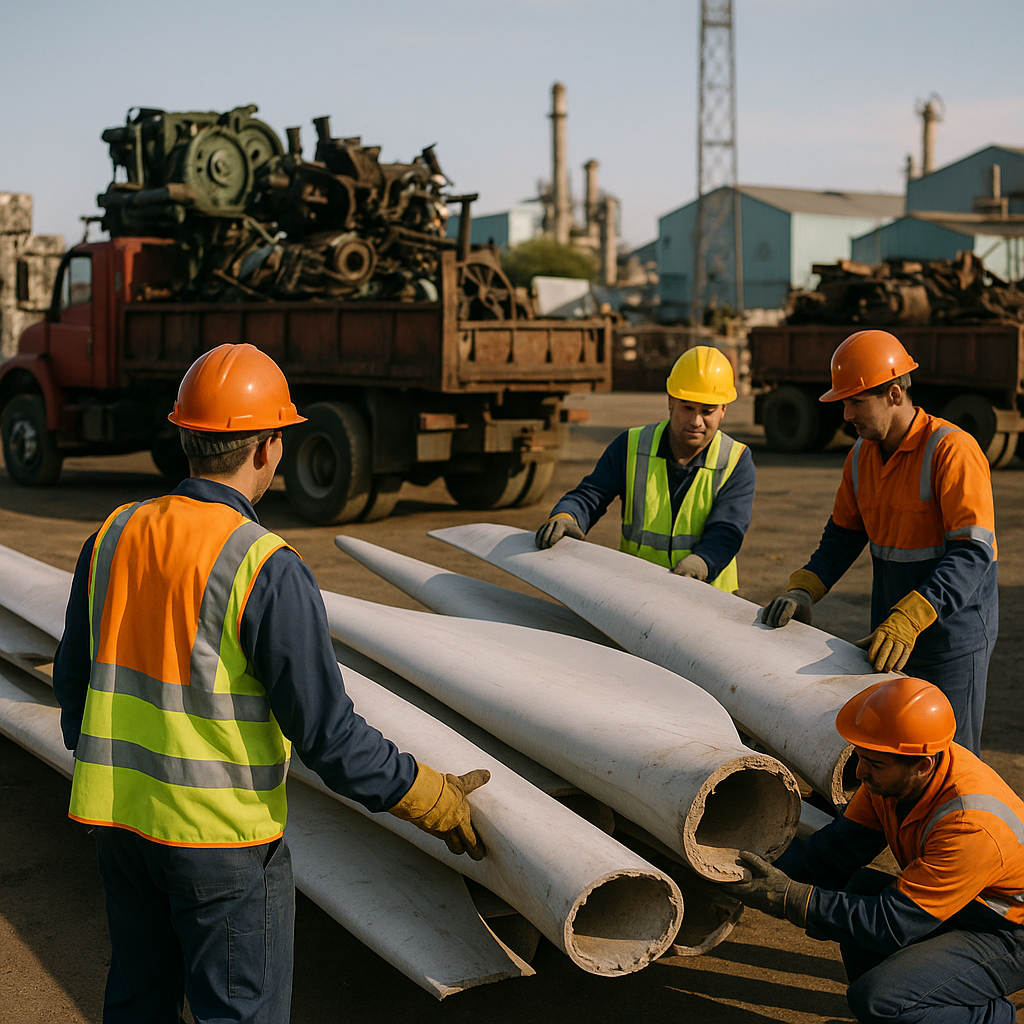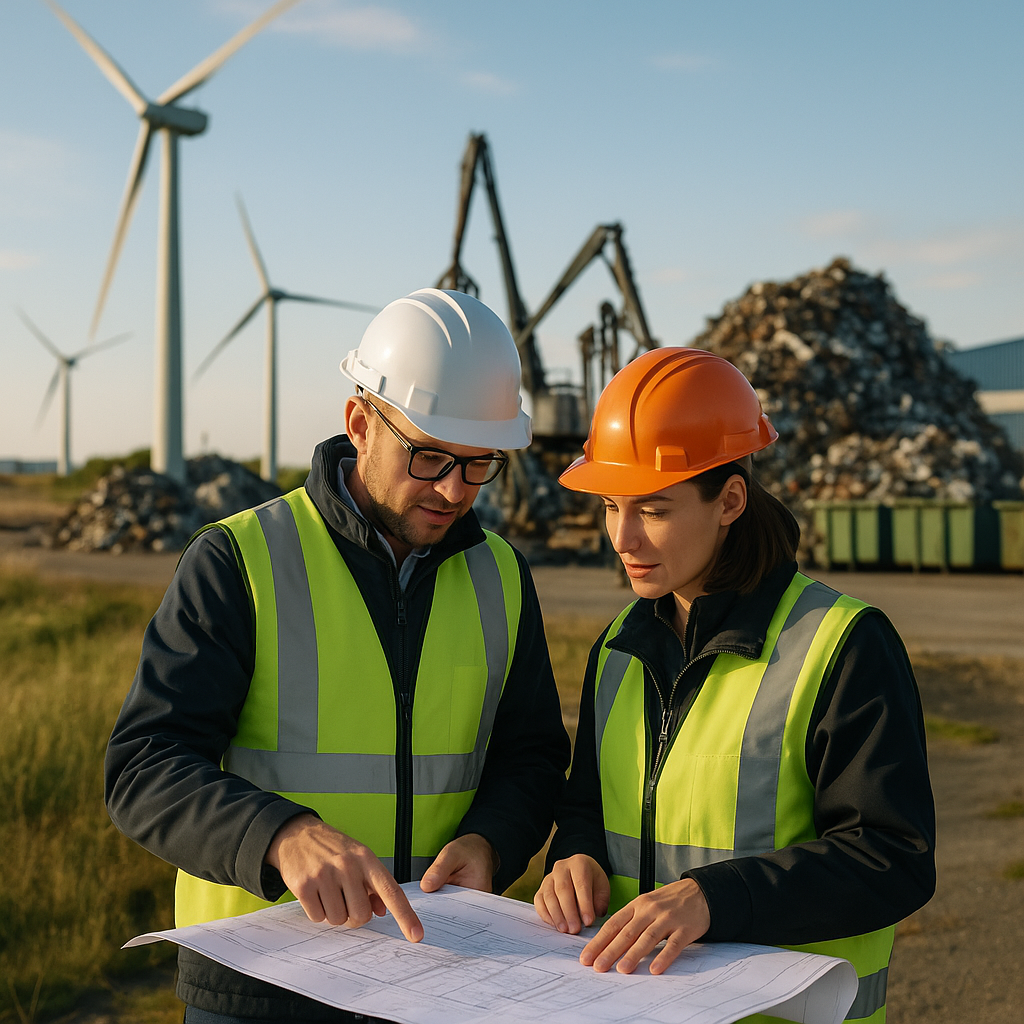5901 Botham Jean Blvd, Dallas, TX 75215
What are the Logistical Challenges of Wind Turbine Removal?
July 30, 2025Imagine a massive wind turbine blade—nearly 100 meters long—suspended in midair as specialized cranes work to dismantle it piece by piece. This scene is becoming increasingly common as the first generation of wind turbines reaches the end of their operational life. The immense size of these structures presents significant challenges during their removal.
Removing wind turbines is one of the most complex logistical tasks in the renewable energy sector. These towering structures, built to endure extreme weather conditions for decades, are not easily dismantled. The process requires careful coordination of specialized equipment, skilled personnel, and precise timing to safely disassemble components weighing several tons each.
Transportation is another major obstacle. Wind turbine blades are not only massive but also awkwardly shaped, making them exceptionally difficult to transport on conventional roadways. Their size often necessitates special permits, escort vehicles, and carefully planned routes to navigate bridges, tunnels, and turns. A single blade may require multiple specialized trucks and road closures, creating logistical nightmares, especially when wind farms are located in remote areas.
What Is the Process for Decommissioning and Dismantling Wind Turbines?

The decommissioning of a wind turbine requires a well-coordinated series of activities to ensure safety, environmental protection, and material recovery. The process begins with a thorough site assessment and planning phase. Engineers evaluate the structural integrity of the turbine, access routes for heavy equipment, and any site-specific environmental considerations, such as protected habitats or proximity to water sources.
Step-by-Step Dismantling Process
- Site Preparation and Permitting: Permits must be obtained from local, state, and federal agencies. Access roads are reinforced, laydown areas are cleared, and environmental safeguards like erosion barriers are installed.
- Power Isolation and Disconnection: The turbine is shut down and disconnected from the grid. Specialized crews ensure all electrical and mechanical systems are de-energized and safe for dismantling.
- Tower and Nacelle Removal: Large cranes detach the nacelle (housing the gearbox and generator) from the top of the tower. The tower sections are unbolted, cut, or carefully lowered—sometimes in multiple parts to meet transportation limitations.
- Blade Dismantling: Turbine blades are typically detached one at a time using synchronized lifting equipment and rigging systems. Due to their size and weight, removing each blade can take several hours and requires precise coordination to avoid damage or accidents.
- Onsite Segmentation: To facilitate transport, components—especially blades and tower sections—are often cut or segmented on site using specialized saws and handling gear. Materials are then sorted for recycling, repurposing, or proper disposal.
- Site Restoration: Once all components are removed, the foundation is broken up and excavated, or left in place if permitted. The site is graded, revegetated, or restored to its prior use according to regulatory requirements and landowner agreements.
Successful decommissioning minimizes risks to personnel, reduces the environmental footprint, and maximizes the recovery of valuable materials for recycling or reuse.
Key Logistics, Safety, and Regulatory Factors in Wind Turbine Removal

The removal of wind turbines requires careful consideration of logistics, occupational safety, and regulatory compliance—each of which can greatly influence project timelines and costs.
Logistical Challenges
Transporting wind turbine components, particularly blades and tower segments, demands specialized trucks, trailers, and often route surveys to ensure bridges, tunnels, and turns can be safely navigated. Transport may be limited to certain times of day, and road closures are sometimes necessary to accommodate oversized loads. In some cases, waterways or rail systems are used for particularly challenging routes.
Safety Considerations
Wind turbine dismantling exposes workers to risks such as falls, electrical hazards, and the handling of heavy or suspended loads. Strict adherence to OSHA regulations, comprehensive safety training, and the use of personal protective equipment (PPE) are mandatory. On-site crews must also be prepared to manage unexpected events, such as adverse weather or equipment malfunctions, which can delay removal or create additional hazards.
Regulatory Requirements
Wind farm decommissioning is regulated at multiple levels. Local governments may set rules for road use and site restoration, while state agencies might require environmental impact studies or reclamation bonds. At the federal level, agencies like the U.S. Fish and Wildlife Service may oversee decommissioning in areas with protected species or habitats. Increasingly, permits require detailed decommissioning and recycling plans before new wind projects are approved.
By proactively addressing logistics, safety, and regulatory compliance, wind farm operators can avoid delays, control costs, and ensure that turbine removal is performed to the highest environmental and industry standards.
How are Wind Turbine Materials Disposed of or Recycled?

Disposing of wind turbines poses a complex challenge for the renewable energy sector. Approximately 85-90% of a wind turbine’s total mass can be recycled through established practices. Components such as the outer shell, shafts, gearing, and electrical parts, usually made from steel, copper, aluminum, and other metals, have significant scrap value and established recycling pathways.
A major recycling hurdle is the turbine blades. These large structures—some exceeding 100 meters in length—are composed of composite materials engineered for durability rather than recyclability. Wind turbine blades contain fiberglass, carbon fiber, and thermoset resins that create a rigid, cross-linked polymer structure, which is exceptionally difficult to break down.
The Growing Scale of Blade Disposal
The scale of this issue is significant and growing. According to the National Renewable Energy Laboratory, the cumulative mass of decommissioned blades in the U.S. will reach 1.5 million metric tons by 2040 and 2.2 million metric tons by 2050. Globally, this figure could be as high as 43 million metric tons by mid-century.
Currently, between 8,000 and 9,000 blades are removed annually in the U.S., with expectations to increase to 10,000-20,000 annually by 2030. These blades require special handling due to their size and complex composition.
Traditional Disposal Methods
Until recently, landfill disposal has been the primary method for wind turbine blades. This method is problematic for several reasons. The blades are difficult to stack due to their shape and material memory, and once stacked, they do not compact efficiently when covered. Their non-biodegradable nature means they remain intact for centuries, creating a long-term disposal challenge.
Innovative Recycling Solutions
Several promising recycling methods are being developed:
- Cement Co-Processing: Companies like Veolia North America have teamed with GE Renewable Energy to shred blades into smaller pieces usable as raw material for cement production. This method reduces CO₂ emissions by 27% and water consumption by 13% compared to traditional cement manufacturing.
- Mechanical Recycling: Global Fiberglass Solutions has developed a process to convert pulverized blade material into composite pellets for use in construction panels, flooring, shipping pallets, and railroad ties.
- Pyrolysis: This technique involves heating the composite material above 300°C without oxygen to break down the resin into usable byproducts while recovering glass fibers for reuse in new materials.
- Chemical Recycling: Emerging solvolysis methods use chemicals to dissolve the resin binding the fibers, allowing recovery of clean fibers that retain most of their original mechanical properties.
Beyond recycling, creative repurposing initiatives are finding second lives for blades as bike sheds, noise barriers, playground equipment, pedestrian bridges, and even “glamping pods” at festival sites.
Future-Focused Design Solutions
Manufacturers are working to improve recyclability at the design stage. Siemens Gamesa has developed recyclable wind turbine blades using a special resin called Recyclamine, which includes engineered cleavage points. When the blade reaches end-of-life, it can be immersed in a heated, mildly acidic solution that dissolves the resin, allowing materials to be recovered and reused.
Other manufacturers are exploring thermoplastic resins instead of traditional thermosets. Unlike thermosets, thermoplastics can be melted and reformed multiple times, making them more recyclable while still providing the necessary performance characteristics.
Collaboration efforts like the DecomBlades consortium and the ZEBRA (Zero wastE Blade ReseArch) project bring together turbine manufacturers, recyclers, and researchers to develop comprehensive, economically viable recycling solutions.
[[artifact_table]]Wind Turbine Blade Recycling Methods Comparison[[/artifact_table]]As regulations tighten—countries like Germany, the Netherlands, Austria, and Finland have already banned blade landfilling—the industry is accelerating efforts to develop sustainable solutions. While technical solutions exist, making recycling economically viable compared to landfilling, especially in regions with ample landfill space, remains a crucial challenge for widespread adoption of innovative recycling approaches.
Conclusion: The Future of Wind Turbine Decommissioning

The wind energy sector has reached a pivotal stage in its development. As more turbines near the end of their operational lifespan, efficient and sustainable decommissioning processes are increasingly crucial. Recent advancements in recycling technology are transforming waste into valuable resources. Companies like Carbon Rivers and Veolia lead in recovering glass fibers from blades for new composite products, while cement co-processing offers an alternative, reducing CO2 emissions in cement production.
Regulatory frameworks are evolving to address decommissioning challenges. Several European countries have implemented landfill bans for turbine blades, and similar discussions are ongoing in the United States. These regulations, along with industry-led initiatives such as the DecomBlades and ZEBRA projects, are driving the sector toward more circular economy solutions. As these technologies advance and costs decrease, a greater percentage of turbine components are expected to be recycled or repurposed rather than landfilled. For help with your recycling needs, contact Okon Recycling at 214-717-4083.
